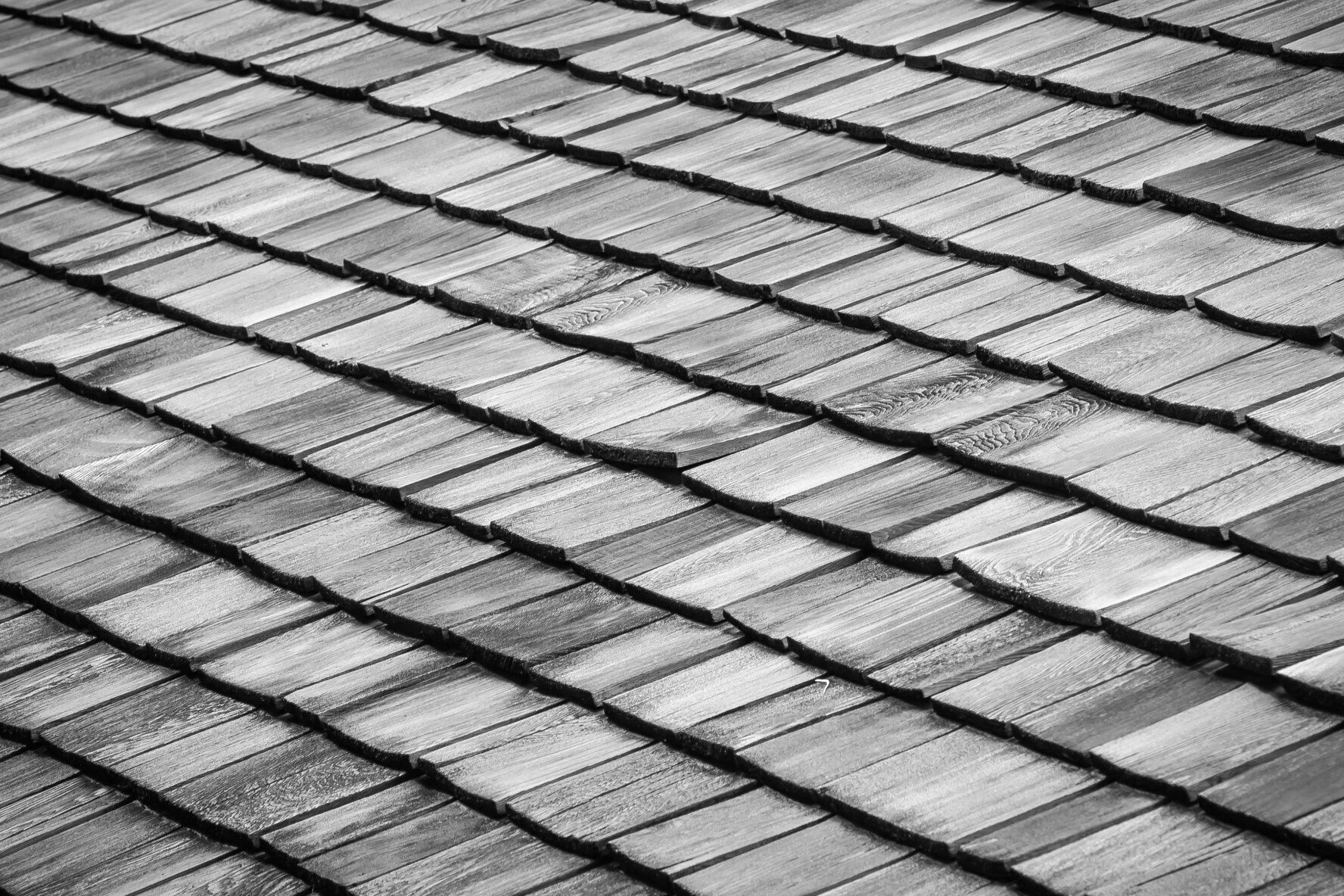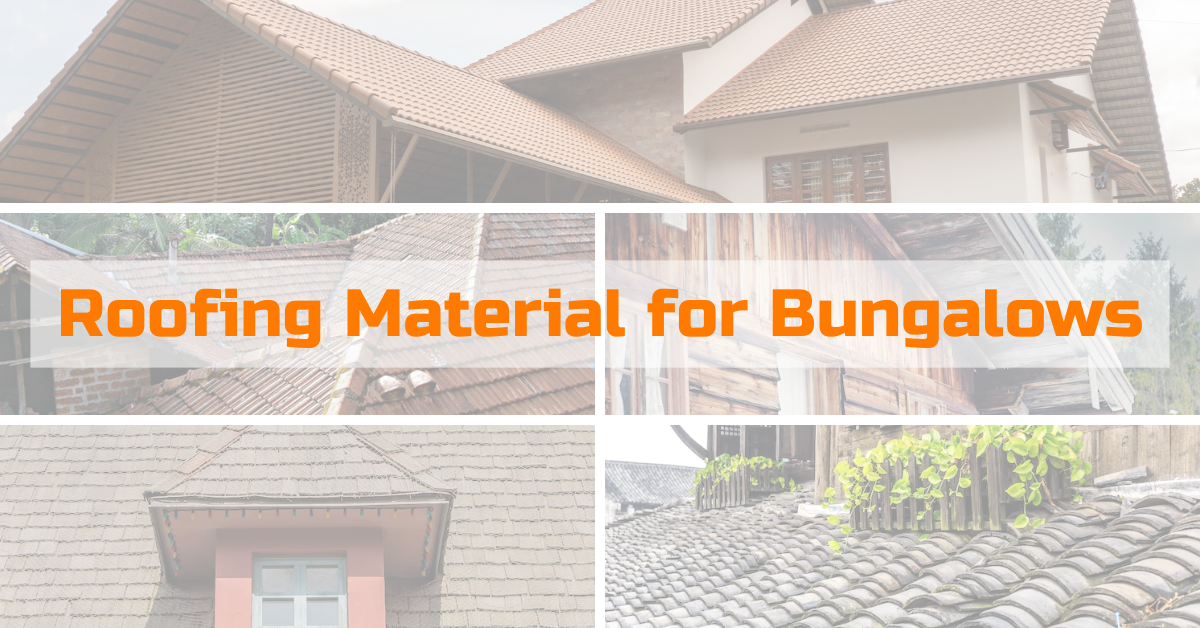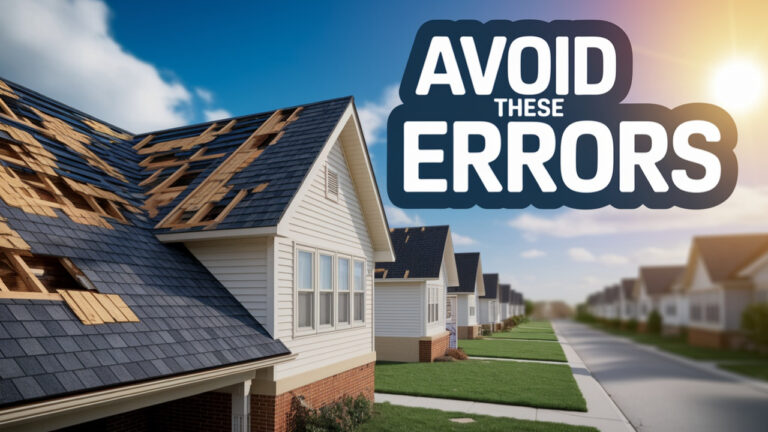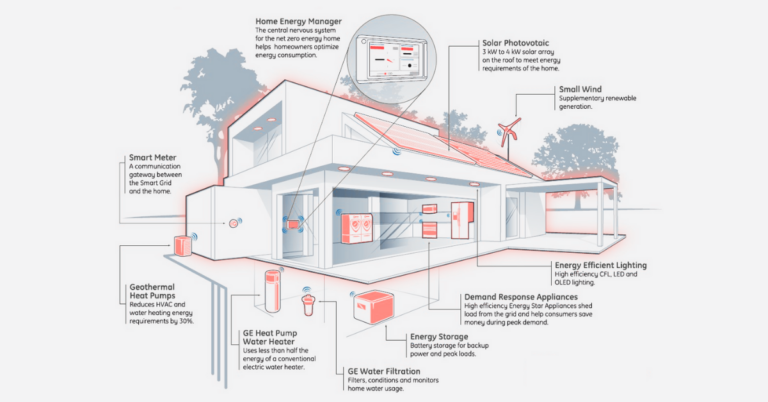The roof is one of the most important components of any building, especially when it comes to a bungalow. It not only protects your home from the elements but also adds to its overall aesthetic appeal. When it comes to choosing the best roofing material for bungalows there’s much more to consider than just the look. Factors like durability, climate, cost, and material availability all play a role in the decision-making process.
Whether you’re building a new bungalow or replacing the roof of an existing one, selecting the best roofing material for bungalows and style is essential to ensuring the long-term safety, energy efficiency, and visual appeal of your home. This guide will help you navigate the complexities of choosing the best roofing for your bungalow, ensuring you make a smart investment.
Let’s explore the essential factors that go into selecting the ideal roof for your bungalow.
Outline:
- Understanding the Importance of Roofing for a Bungalow
- Protection and safety
- Aesthetic value
- Energy efficiency and cost savings
- Factors to Consider When Choosing a Roof for Your Bungalow
- Climate and weather conditions
- Budget and material costs
- Roof longevity and maintenance
- Aesthetic and design compatibility
- Types of Roofing Material for Bungalows
- Asphalt shingles
- Metal roofing
- Clay and concrete tiles
- Slate roofing
- Wooden shingles and shakes
- Green roofs
- Roofing Styles for Bungalows
- Gable roof
- Hip roof
- Flat roof
- Mansard roof
- Choosing the Best Roofing Material for Bungalows Based on Climate
- Roofing materials suited for hot climates
- Roofing materials for cold climates
- Roofing for heavy Rainfall areas
- Installation and Maintenance Considerations
- Professional installation vs. DIY
- Routine maintenance and care
- Common roofing problems to avoid
- Conclusion
- Recap of choosing the best roofing for your bungalow
- Final tips for making the right decision
1. Understanding the Importance of Roofing for a Bungalow
Choosing the best roofing for your bungalow is not just about making the building look attractive; it’s about ensuring its safety and functionality. Let’s break down why roofing is so crucial for your bungalow:
Protection and Safety
The roof is your home’s primary shield against the elements. Whether it’s harsh sunlight, torrential rain, high winds, or even snow, the roof must be durable enough to withstand these forces. A good roof ensures the structural integrity of your bungalow, preventing leaks, water damage, and the growth of mold and mildew. It also provides insulation to keep your home safe and comfortable throughout the year.
Aesthetic Value
Your bungalow’s roof significantly impacts its curb appeal. The roof’s color, texture, and shape can either enhance or detract from the overall design of your home. A well-chosen roof not only complements the architectural style of your bungalow but can also increase the value of your property.
Energy Efficiency and Cost Savings
The right roofing material can help regulate the temperature inside your home, reducing the need for excessive heating or cooling. Roofing materials with good insulation properties can help you save on energy bills. Additionally, durable roofing materials tend to require less maintenance, which can save you money in the long term.
2. Factors to Consider When Choosing a Roof for Your Bungalow
Choosing the best roofing for your bungalow involves balancing several factors. Here are the key elements to consider:
Climate and Weather Conditions
One of the most important considerations is your local climate. Different roofing materials perform better in different environments. For instance, metal roofs are ideal for areas with heavy rainfall, while clay tiles are better for areas with a hot and dry climate. Consider the temperature extremes, humidity, and potential for storms or snow when choosing a material.
Budget and Material Costs
The cost of roofing materials can vary widely, so it’s important to determine a realistic budget for your bungalow roofing project. Some materials, like asphalt shingles, are cost-effective but may have a shorter lifespan. Others, like slate or metal, may be more expensive upfront but offer long-term savings due to their durability.
Roof Longevity and Maintenance
Consider how long the roofing material will last and how much maintenance it will require. Some materials, such as asphalt shingles, may need to be replaced every 20-30 years, while others, like metal or slate, can last up to 50 years or more. Factor in both installation and long-term maintenance costs when choosing the best roofing for your bungalow.
Aesthetic and Design Compatibility
Your roof should complement the design of your bungalow. For example, if you have a traditional bungalow, you might opt for clay tiles or wooden shingles. For a modern bungalow, sleek metal roofing or flat roofs might be more appropriate. Consider the overall style and design of your home to ensure the roof enhances the overall look.
3. Types of Roofing Material for Bungalows
3. Types of Roofing Materials for Bungalows
Common Roofing Materials Used for Bungalows
Picking the best roofing material is important for how long your bungalow lasts, how much energy it uses, and how it looks. Here are the most common choices, with their good and bad points:

Asphalt Shingles
Asphalt shingles are one of the most popular roofing materials in North America, known for their affordability and ease of installation. They are made from a fiberglass or organic base that is saturated with asphalt and coated with mineral granules. Available in a wide variety of styles, colors, and textures, asphalt shingles can complement nearly any home design.
- Advantages: Asphalt shingles are cost-effective, making them ideal for budget-conscious homeowners. They are adaptable to different architectural styles and are widely available in various colors and designs. In addition, they are easy to repair or replace, which adds to their convenience over time.
- Disadvantages: One of the main drawbacks of asphalt shingles is their relatively short lifespan, typically lasting between 15 to 30 years. They are also less durable in extreme weather conditions and may not hold up well in areas prone to high winds, heavy rain, or sudden temperature changes. Over time, exposure to the elements can cause them to crack, curl, or lose granules, which may affect their overall performance and appearance.
Metal Roofing
Metal roofing is renowned for its energy efficiency and impressive longevity, making it an excellent choice for modern bungalows. It is built to last, often providing reliable protection for up to 70 years. Metal roofs are highly resistant to harsh weather conditions, including strong winds, heavy rain, and even fire, which adds to their appeal in areas prone to extreme weather. Additionally, metal roofing reflects sunlight effectively, helping to keep homes cooler and reduce energy costs.
- Benefits: Metal roofing is extremely durable and can withstand the elements far better than many other roofing materials. It requires very little maintenance over its lifespan, making it a low-upkeep option. Its energy efficiency helps lower cooling expenses, contributing to long-term savings.
- Cons: The primary downside of metal roofing is the higher upfront cost compared to traditional roofing materials like asphalt shingles. Another potential drawback is that metal roofs can be noisier during rain or hailstorms, which might be a concern for some homeowners unless proper insulation is added.
Clay and concrete tiles

Clay tiles are especially suitable for hot climates because they help keep buildings cool while adding a traditional, timeless look to the home. Their natural thermal properties allow them to reflect heat, making interiors more comfortable during warm weather. Besides their practical benefits, clay tiles offer a classic and elegant appearance that enhances the architectural style of many homes.
- Benefits: Clay tiles are very durable and can last for decades with minimal maintenance. They are energy-efficient, helping to regulate indoor temperatures and reduce cooling costs. Additionally, their aesthetic appeal makes them a popular choice for homeowners seeking a distinctive and attractive roofing option.
- Disadvantages: One of the main drawbacks of clay tiles is their heavy weight, which may require additional structural support to safely hold the roof. They tend to be more expensive upfront compared to other roofing materials. This cost, combined with the need for possible reinforcement, can make installation more complex and costly.
Slate Roofing
Slate roofing is known for its unique beauty and exceptional strength, offering a roofing solution that can last over 100 years with very little maintenance. Its natural stone appearance adds a luxurious and elegant finish to any home, making it a favored choice for those seeking both durability and aesthetic appeal. Slate is highly resistant to weather, fire, and decay, ensuring long-lasting protection.
- Advantages: Slate is extremely durable and can withstand harsh environmental conditions better than most roofing materials. It requires minimal upkeep over its lifetime, making it a practical long-term investment. Its distinctive, high-end look adds significant curb appeal and value to a property.
- Drawbacks: Slate is extremely heavy, which often means the roof structure must be reinforced to support the weight. It is also one of the more expensive roofing materials both in terms of material cost and installation. Because of its complexity and weight, slate roofing requires skilled professional installation, which can add to the overall expense.
Wood shingles and shakes

Wood roofing is well-suited for homes with a rural or traditional aesthetic, making it a great match for many bungalow designs. The natural texture and warm tones of wood shingles or shakes add a charming, rustic appeal that blends seamlessly with natural surroundings and classic architectural styles.
- Benefits: Wood roofing provides a beautiful, natural appearance that enhances the overall scenery and character of traditional buildings. It complements a variety of bungalow styles, adding to the home’s charm and curb appeal.
- Disadvantages: Wood roofs require regular maintenance to protect against weathering, rot, and moss growth. They are also more vulnerable to insect damage and have a higher risk of fire compared to other roofing materials, which means extra precautions and treatments are often necessary to ensure safety and longevity.
Green Roofs
Green roofs, which are planted with vegetation, offer a sustainable and eco-friendly roofing option that provides excellent insulation benefits. By covering the roof with plants, they help reduce heat absorption, keeping buildings cooler in the summer and better insulated in the winter. This natural layer also improves air quality and supports biodiversity, making green roofs an environmentally conscious choice.
- Advantages: Green roofs are highly environmentally friendly, helping to reduce the urban heat island effect and lowering energy costs through superior insulation. They contribute to better stormwater management and provide additional green space, which benefits both homeowners and the community.
- Disadvantages: The installation of green roofs can be expensive and more complex than traditional roofing systems, often requiring specialized knowledge and structural considerations. They also demand ongoing maintenance to ensure the health of the plants and the integrity of the roofing system, which can add to long-term costs.
Each roofing material has its own strengths and weaknesses. Choosing the most suitable option depends on factors like your local climate, budget, and the architectural style of your home.
4. Roofing Styles for Bungalows
The style of your roof should also be chosen based on the design of your bungalow. Here are the most common roofing styles for bungalows:
Gable Roof
The gable roof is one of the most common and recognizable styles for bungalows. It consists of two sloping sides that meet at a central ridge, forming a classic triangular shape. This design is highly effective at shedding water and snow, which makes it suitable for a wide range of climates. Its simple construction also makes it a cost-effective and practical roofing option.
Hip Roof
A hip roof features slopes on all four sides, converging at the top to form a ridge or a point. This design is more stable and durable than a gable roof, especially in regions prone to high winds or storms. The aerodynamic shape helps reduce wind uplift, making it a preferred choice in areas with severe weather conditions.
Flat Roof
Flat roofs are favored in modern bungalow designs for their clean, minimalist look. Unlike pitched roofs, flat roofs offer additional usable outdoor space, which can be transformed into terraces, gardens, or lounge areas. While they require careful waterproofing and drainage solutions, flat roofs provide a versatile option for contemporary homes and are an important roofing material for bungalows.
Mansard Roof
The mansard roof is distinguished by its four-sided design with two different slopes on each side: a steep lower slope and a gentler upper slope. This style is ideal for creating extra living space within the attic or upper floors of a bungalow. Its unique shape adds architectural interest while maximizing usable interior space.
5. Choosing the Best Roofing Material for Bungalows Based on Climate
The climate plays a significant role in choosing the best roofing material for your bungalow. Here’s how different roofing materials perform in various climates:
Hot Climates
For hot climates, roofing materials like metal roofing, clay tiles, and concrete tiles are excellent choices. These materials offer superior heat resistance, helping to reflect sunlight and keep your bungalow cooler inside. Their natural properties and designs make them ideal for reducing heat absorption and improving energy efficiency in warmer regions.
Cold Climates
In colder climates, it’s important to select roofing materials that can handle snow, ice, and freezing temperatures. Metal roofs and asphalt shingles paired with proper insulation perform well in these conditions. These materials are durable, shed snow easily, and can prevent ice damming, helping to protect your home during harsh winters.
Heavy Rainfall Areas
For areas prone to heavy rainfall, water resistance and efficient drainage are key. Asphalt shingles, metal roofing, and slate roofing are great options because they allow water to run off quickly, reducing the risk of leaks and water damage. To ensure long-term durability, using a waterproof underlayment and professional installation is essential for preventing moisture penetration and maintaining roof integrity.
6. Installation and Maintenance Considerations
Once you’ve selected the best roofing material for your bungalow, the next crucial step is ensuring proper installation and ongoing maintenance. Hiring professional roofers who specialize in the material you’ve chosen is highly recommended to guarantee the roof is installed correctly and meets all safety and quality standards. Regular maintenance plays a vital role in extending the lifespan of your roof this includes cleaning gutters to prevent water buildup, inspecting for any signs of damage or leaks, and addressing issues promptly before they worsen. Taking these steps will help protect your home and keep your roof performing at its best for years to come.
Conclusion
Choosing the best roofing for your bungalow is an important decision that impacts both the appearance and functionality of your home. By considering factors such as climate, budget, durability, and aesthetic preferences, you can find a roofing material for bungalows that meets your needs. Whether you choose a classic asphalt shingle roof, an elegant slate roof, or a modern metal roof, ensure that your choice complements the design of your home and enhances its overall curb appeal.




